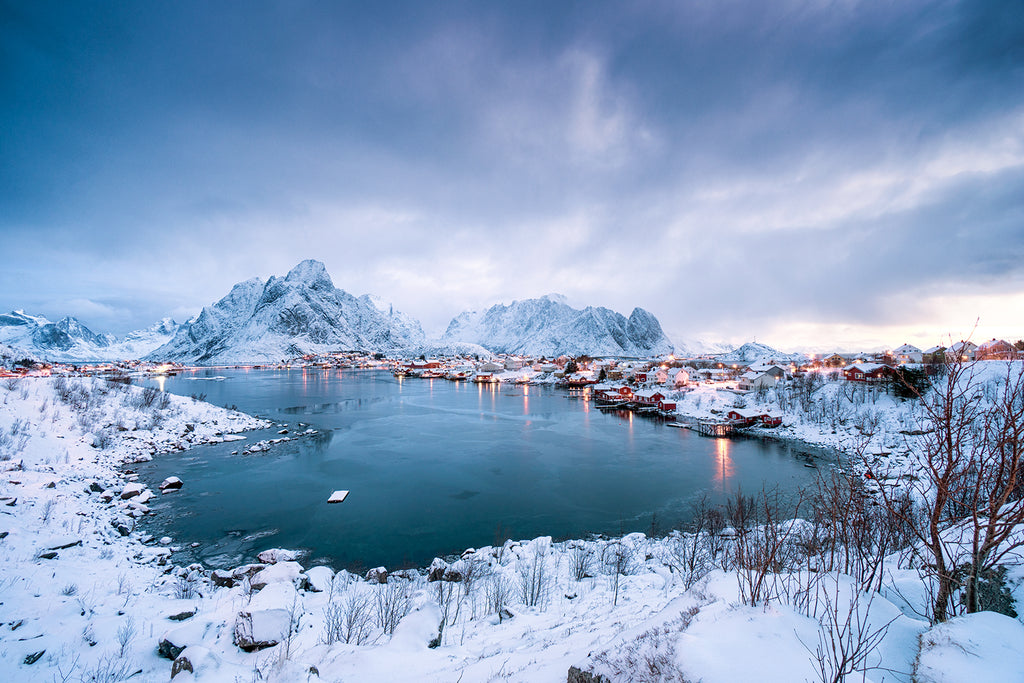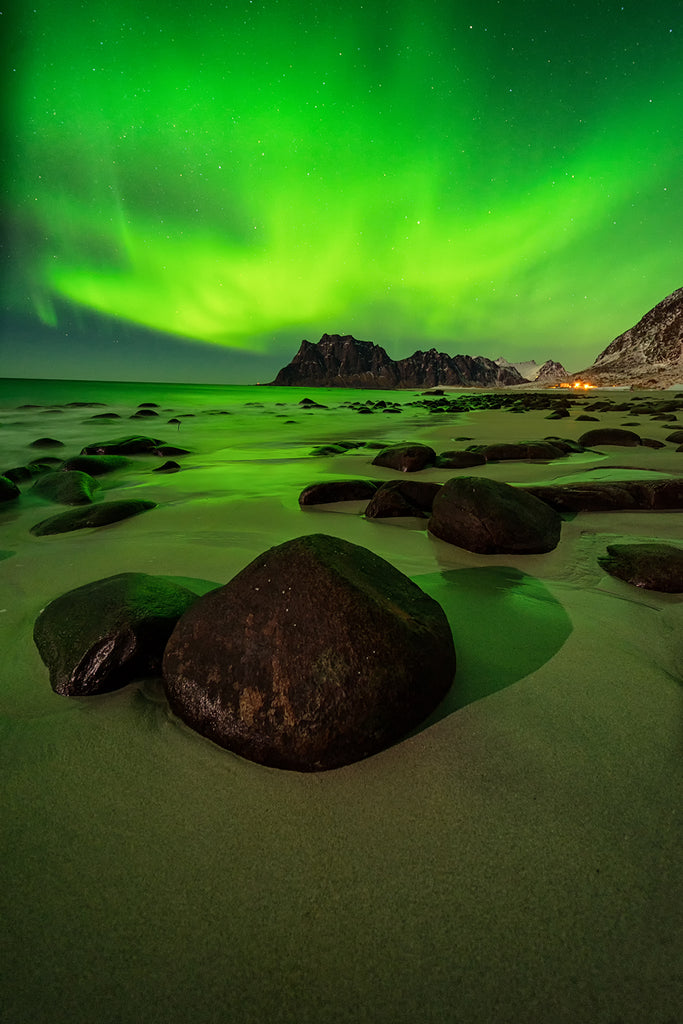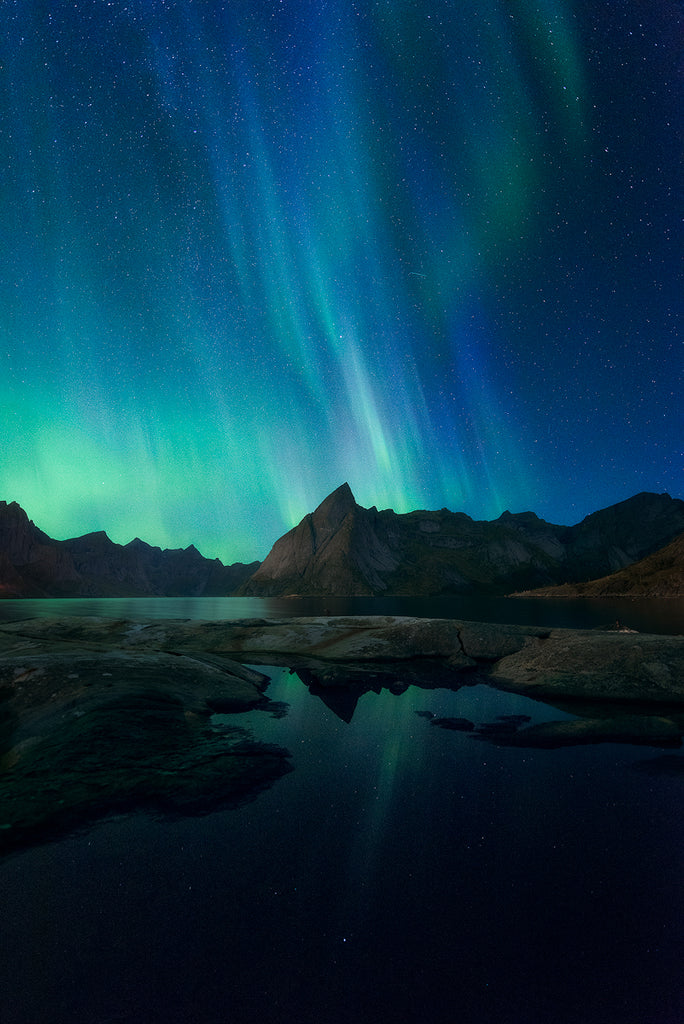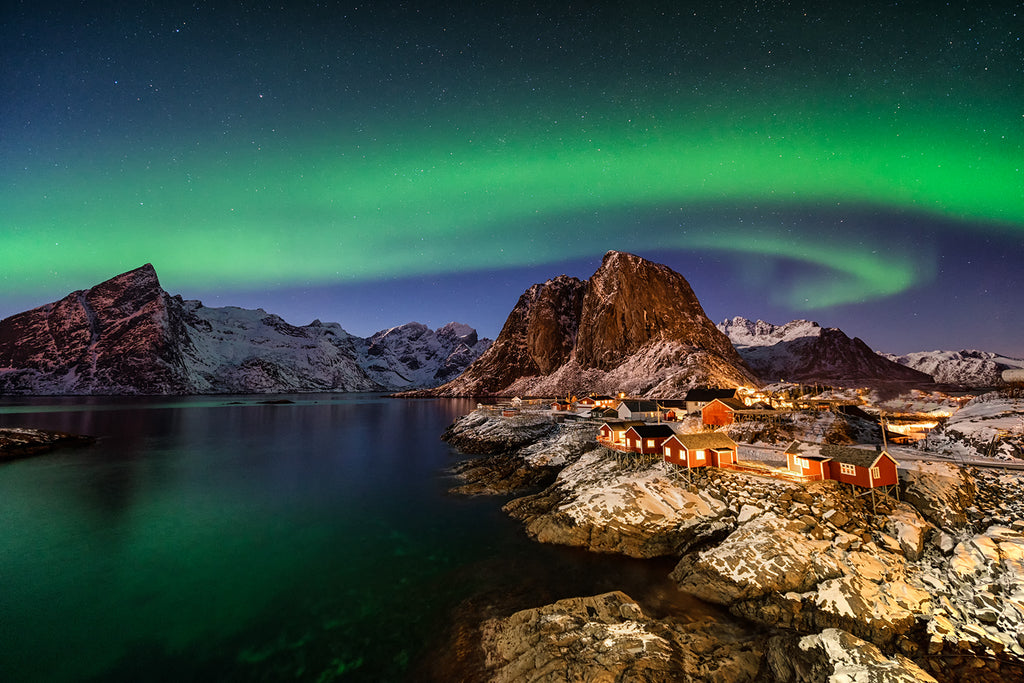Your Cart is Empty
Free Shipping over €125 ✔ Free Exchanges in EU & UK ✔
Free Shipping over €125 ✔ Free Exchanges in EU & UK ✔
Free Shipping over €125 ✔ Free Exchanges in EU & UK ✔

May 19, 2019
Cover photo by Aurore Afilante.
 Ever since The New York Times named Lofoten one of the top places to visit in 2017, tourism on this picturesque set of islands has been steadily on the rise and for good reason. More than 160km north of the Arctic Circle, Lofoten provides a sneak peek into dozens of charming fishing villages and hearty Norwegian living among the giant fjords. With sweeping landscapes and stunning vistas around every corner, Lofoten as quickly rose to be a bucket list place for winter-loving landscape photographers.
Ever since The New York Times named Lofoten one of the top places to visit in 2017, tourism on this picturesque set of islands has been steadily on the rise and for good reason. More than 160km north of the Arctic Circle, Lofoten provides a sneak peek into dozens of charming fishing villages and hearty Norwegian living among the giant fjords. With sweeping landscapes and stunning vistas around every corner, Lofoten as quickly rose to be a bucket list place for winter-loving landscape photographers.
The iconic Lofoten landscapes you’ve seen pop up in the past few years showcase blizzard coastal fishing villages, brightly coloured aside cabins and the internal Polar Night with sunset-like lighting instead of a rising sun. For those who stick it out, you might even see the elusive Northern Lights dance across the sky. If it’s not already, Lofoten should be high on your list.
Lofoten is made up of four main fjord-rich Islands (Austvågøy, Vestvågøy, Moskenesøy, and Flakstadøy) and numerous other smaller islands making it a great place to see rocky inlets, 1,000-meter rock walls, and tiny seaside fishing villages.
1. Reine: Reine is one of the first villages you’ll encounter when you take the ferry into Moskenes. Similar to the other towns, Reine is dominated by postcard-worthy brightly coloured cabins, fishing racks, and tall fjords. There are numerous vantage points for capturing great images in Reine including the wooden bridge that links a small island long Lofoten’s main road, E10. With a wide angle lens, you’ll be able to capture the entire scene!
In north Reine, head towards the local Coop supermarket which will provide you with amazing views across the Reinevagen Bay. On a nice calm day, lake reflections are plentiful.

Photo by Pedro Kin.
2. Hamnøy: Perhaps one of the most recognizable spots in Lofoten, Hamnøy is a small coastal village famous for its iconic seaside red cabins in a picturesque bay surrounded by towering fjords, offering one of the most spectacular vistas in Lofoten. Check out the Hamnøy bridge for a perfect shot set up for the coastal village. If you’re lucky with a clear night, you can even get the Northern Lights dancing across the town.

Hamnoy. Photo by Christian Hoiberg.
3. Vestvågøy Beaches: From fjords to beaches, Lofoten has it all. Spend some time in the east and visit some of the most scenic beaches in Lofoten such as Haukland, Vik, Uttakleiv, and Unstad. White sand and turquoise blue water give you an interesting foreground with tall snowcapped fjords in the distance. The enteral blue light during winter promises great photo opportunities of these rocky beaches.

Photo by Pedro Kin.
In Lofoten, you’re likely to see a photo-worthy spot every 20 meters so it can be a bit overwhelming to decide on what to see. The best advice is to keep a flexible schedule and allow yourself time to explore quiet roads or hidden corners you stumble upon. For a rough guide, these are some of our favourite must-see spots in Lofoten.
Ramberg Beach: If you’re in the midst of a Lofoten road trip, you’ll no doubt cross paths with Ramberg Beach at some point and when you do, it’s definitely worth a pit stop to stretch the legs and photograph this beautiful little beach. A short walk from the car park will reveal a solitary red cabin perfectly placed infant of picture-perfect seaside mountains.
Skagsanden: Skagsanden is one of Lofoten's most photographed beaches, and is a great spot for those looking to photograph the Northern Lights. It's located only 5km from Ramberg Beach.
 Photo by Pedro Kin.
Photo by Pedro Kin.
Nusfjord: Nestled into a narrow fjord that feels far from everything, Nusfjord is one of the more stunning villages in Lofoten. You’ll see the iconic red and yellow fishing cabins with ample photo opportunities.
Kabelvåg: This small fishing village is more than picturesque. It’s also steeped in rich history and is a great place to learn about the important roll fishing has played in Lofoten. The Lofoten Museum will give you a good insight into what life was like in the 1800s as a Lofoten resident. After a stroll through the museum, head outside to photograph the picture-perfect village. Don’t forget to visit the Vågan Church, the largest wooden church north of Trondheim.
Å: Lofoten’s most western point promises spectacular views and classic fishing village vibes. Scenic fjords surrounding wooden cabins dominate the scenery here (are you sensing a theme yet?) but when the light disappears and you looking for things to do, head to the Stockfish Museum or the Norwegian Fishing Village Museum to learn more about the region and the importance of fishing to the Lofoten people.
Røst Islands: This region is only accessible by boat so of course it’s naturally one of the most nature rich areas in Lofoten. Located about 100km from the mainland, this region is home to millions of puffins as well as the rarer storm petrels and fulmars. These islands are believed to hold a quarter of all of Norway’s bird population so a for the wildlife lovers, this region is not to be missed.
Fredvang: Fredvang is a village located on the Moskeneøya Island. It's an isolated village and the only road access is via the Fredvang Bridges.

Photo by Pedro Kin.
Unstad Arctic Surf Beach: Arctic surfing is not for the faint of heart and while most people will opt to stay in their warm woolly layers, this is still a great place to watch and photograph Arctic Surfers. If you’re feeling brave, you might even be tempted to try it yourself. They say you’ll be warmer if you’re moving in the water and there’s only one way to find out!

Photo by Hallvard Kolltveit
Sakrisøya: Sakrisøya is another beautiful and well known coastal settlement tucked between Reine and Hamnøy, famous for it’s restored yellow fishing cabins. Fish drying racks and mountain landscapes dominate the scenes in Sakrisøya giving you an honest look into Norwegian fishing culture.
Photo by Pedro Kin
Trollfjord: It’s true that Trollfjord is one of Lofoten’s most popular boat excursions but it truly is one of the best views in all of Lofoten. At 3.2 km long, Trollfjord is a mountain lake surrounded by Higravtinder and Trolltinder mountains, both jutting out of the water rising to over 1,000m tall. You may even get to see the famed Sea Eagles who frequent the area.

Photo by Pedro Kin.
Mortsund: Mortsund is a remote fishing port south of Leknes in the heart of Lofoten. There's not much commercial activity here but this location makes for great photos due to the iconic fishing huts, calm port waters and Northern Lights visibility.
 Photo by Pedro Kin.
Photo by Pedro Kin.
As with most popular travel destinations, Lofoten is super busy and crowded in the peak summer seasons, however, if you want to be out hiking and enjoying the outdoors, warmer weather and longer days will obviously be more fitting.
For those looking to hone their photography skills and experience a moody and snowy Lofoten, December - February is great. As an added bonus, the summer crowds will be gone and you’ll have a much greater chance of getting your shots without pesky tourists wandering into the frame.
Lofoten experiences the Polar Night (24 hours of darkness) in winter. The sun doesn’t really rise but instead, you get a beautiful pastel pink and blue sky in its place. Winter is also the best time to see the Northern Lights but it’s no guarantee. The maritime weather in Lofoten is so unpredictable that the clouds often cover up the Northern Lights in the winter and roll out again just as fast, meaning you need to be ready at all times.
Lofoten sees a lot of rain from September - November so if you’re wanting to see the sights, it’s best to avoid this time frame.

Hamnoy. Photo by Pedro Kin
Car rentals in Norway are not exactly cheap and will generally cost at least 60 Euros per day. You can either drive all the way up from Olso, which will take more than 20 hours, or you can fly to Northern Norway to cut down on time.
Svolvær and Leknes are the two airports on the islands. Round trip flights from Olso will cost around 400 Euro.
For those wanting a more scenic journey, opt to take the ferry from Bodø to Moskenes. While beautiful, costing Vestfjord is not always a smooth ride so if you’re prone to seasickness, keep this in mind. If you are planning to drive around the islands, a good tip is to rent your car from Bodø and take your car on the ferry.
 Uttakliev. Photo by Pedro Kin.
Uttakliev. Photo by Pedro Kin.
We’ll just come right out and say it, Lofoten weather is unpredictable and is not to be underestimated. It’s famous for its fickle weather patterns despite the deceivingly mild-looking average temperatures. One minute the sun is shining and the next, a full-blown storm system has moved in. It might seem crazy but it’s truly just one of the quirks that make Lofoten even more compelling and fascinating.
Average temperatures from December - February range from 2°C - -2°C but at it’s coldest, it can easily reach -20°C. The high winds can make it feel colder than it is so if you’re planning on visiting Lofoten, you’ll without a doubt want to double down on the layers.
 Reine. Photo by Pedro Kin.
Reine. Photo by Pedro Kin.
The E10 is the main road connecting the east and west of Lofoten Islands and the road spans across all of the islands so if you want to avoid ferries, it’s entirely possible to visit all of the hot spots in a car.
For photography purposes, we highly recommend renting a car for your Lofoten trip. Public transportation does exist but if you’re wanting to get to more remote locations during the best light of the day, it’s best not to restrict yourself to a bus schedule. Busses connect the islands and run 4-6 times a day, except for Sunday.

Stortinden. Photo by Christian Hoiberg.
If you’re traveling to Lofoten, it’s important to book all of your accommodation as early as possible. As Lofoten grows in popularity each year, accommodation becomes more and more scarce. When booking accommodation, it’s also a good idea to try to find something with a kitchen because a lot of restaurants close for the winter.
Svolvær, the port town on the south side of Austrvågoy, is the largest town in the area and a great place to base out of. Ballstad, known as the Venice of Lofoten and located in Vestvågøya, is one of the largest fishing villages and is another great place to base out of.
While there are some hotel-like accommodation options available, renting a house or a fishing cabin is more common. For a truly Lofoten experience, stay in the iconic red fishing huts precariously perched above the tidal waters. Many of these sjøhus have been converted into accommodation with some being more basic (with a few bunks and a stove) while others lean towards luxury accommodation.

Hamnoy. Photo by Christian Hoiberg.
Car rentals range from 60 -100 Euro per day and unleaded petrol costs are 1.44 Euros/liter so depending on how much you drive, your car rental might take up a significant amount of your budget. A hotel room will cost at least 100 Euros per night but you may be able to find a cheaper room on Airbnb. Food is notoriously expensive in Norway and most locals opt for making all of their own meals instead of eating out at restaurants. In winter, many restaurants close for the season so it’s best to be prepared to cook your own meals. A meal at an inexpensive restaurant will cost around 23 Euro. Alcohol is also an expensive purchase with a beer costing no less than 11 Euro per pint.

It’s no secret that the weather in Lofoten can be…unpredictable. With the ever-changing weather patterns, you may get lucky with the weather or you may spend the majority of your holiday hiding from the storms and waiting for the perfect weather window. Be prepared to fight the weather and you’ll set yourself up for success. In addition to the weather, the price tag on Lofoten can be a big barrier because Lofoten simply ain’t cheap. There’s really no such thing as a budget Lofoten trip so if this is on your bucket list, start saving now.
Despite the obstacles you need to overcome to have a successful photography trip to Lofoten, the effort will be well worth it in the end. The contrast of the simple but colourful fishing villages with the inhospitable looking fjords defines the region. Each village is worthy of a stop off and great photo opportunities lay quietly around every corner. While it’s a popular location for photographers, there’s always a way to get a unique shot so don’t be afraid to go off the well-trodden path.
Thanks to Pedro Kin and Christian Hoiberg for their photo and location contributions. If you're interested in photographing Lofoten, Norway, snag a spot on their photography workshops by clicking their info below.
Comments will be approved before showing up.

October 01, 2024

September 26, 2024 17 Comments

September 14, 2024